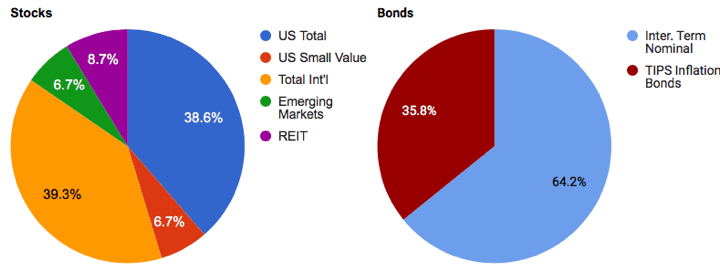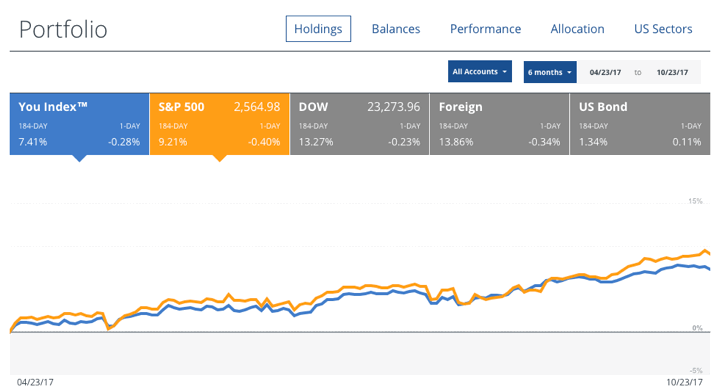
Here is an update on my investment portfolio holdings after the third quarter 2017. This includes tax-deferred 401k/403b/IRAs and taxable brokerage holdings, but excludes things like our primary home, cash reserves, and a few other side investments. The purpose of this portfolio is to create enough income to cover our regular household expenses.
Target Asset Allocation. The overall goal is to include asset classes that will provide long-term returns above inflation, distribute income via dividends and interest, and finally offer some historical tendencies to balance each other out. I don’t hold commodities futures or gold as they don’t provide any income and I don’t believe they’ll outpace inflation significantly. I also try to imagine each asset class doing poorly for a long time, and only hold the ones where I think I can maintain faith.
Stocks Breakdown
- 38% US Total Market
- 7% US Small-Cap Value
- 38% International Total Market
- 7% Emerging Markets
- 10% US Real Estate (REIT)
Bonds Breakdown
- 50% High-quality, Intermediate-Term Bonds
- 50% US Treasury Inflation-Protected Bonds
I have settled into a long-term target ratio is 67% stocks and 33% bonds (2:1 ratio) within our investment strategy of buy, hold, and rebalance. With a self-managed, simple portfolio of low-cost funds, we minimize management fees, commissions, and income taxes.
Actual Asset Allocation and Holdings

Stock Holdings
Vanguard Total Stock Market Fund (VTI, VTSMX, VTSAX)
Vanguard Total International Stock Market Fund (VXUS, VGTSX, VTIAX)
WisdomTree SmallCap Dividend ETF (DES)
WisdomTree Emerging Markets SmallCap Dividend ETF (DGS)
Vanguard Small Value ETF (VBR)
Vanguard Emerging Markets ETF (VWO)
Vanguard REIT Index Fund (VNQ, VGSIX, VGSLX)
Bond Holdings
Vanguard Limited-Term Tax-Exempt Fund (VMLTX, VMLUX)
Vanguard Intermediate-Term Tax-Exempt Fund (VWITX, VWIUX)
Vanguard High-Yield Tax-Exempt Fund (VWAHX, VWALX)
Vanguard Inflation-Protected Securities Fund (VIPSX, VAIPX)
iShares Barclays TIPS Bond ETF (TIP)
Individual TIPS securities
U.S. Savings Bonds (Series I)
Performance and commentary. According to Personal Capital, which aggregates all of my investment holdings across different accounts, my portfolio has gained 7.41% over the last 6 months since my last update. In the same time period, the S&P 500 has gained 9.21% (excluding dividends) and the US Aggregate bond index has gained 1.34%.

Things are currently at 69% stocks/31% bonds. For the most part, I continue to invest new money on a monthly basis in order to try and maintain the target ratios. Once a quarter, I also reinvest any accumulated dividends and interest. I don’t use automatic dividend reinvestment. This way, I can usually avoid creating any taxable transactions unless markets are really volatile.
For both simplicity and cost reasons, I am no longer buying DES/DGS and will be phasing them out whenever there are tax-loss harvesting opportunities. New money is going into the more “vanilla” Vanguard versions: Vanguard Small Value ETF (VBR) and Vanguard Emerging Markets ETF (VWO).
I’m still somewhat underweight in TIPS and REITs mostly due to limited tax-deferred space as I don’t want to hold them in a taxable account. My taxable muni bonds are split roughly evenly between the three Vanguard muni funds with an average duration of 4.5 years. I may start switching back to US Treasuries if my income tax rate changes signficantly.
In a separate post, I will track dividend and interest income.
 The Best Credit Card Bonus Offers – 2025
The Best Credit Card Bonus Offers – 2025 Big List of Free Stocks from Brokerage Apps
Big List of Free Stocks from Brokerage Apps Best Interest Rates on Cash - 2025
Best Interest Rates on Cash - 2025 Free Credit Scores x 3 + Free Credit Monitoring
Free Credit Scores x 3 + Free Credit Monitoring Best No Fee 0% APR Balance Transfer Offers
Best No Fee 0% APR Balance Transfer Offers Little-Known Cellular Data Plans That Can Save Big Money
Little-Known Cellular Data Plans That Can Save Big Money How To Haggle Your Cable or Direct TV Bill
How To Haggle Your Cable or Direct TV Bill Big List of Free Consumer Data Reports (Credit, Rent, Work)
Big List of Free Consumer Data Reports (Credit, Rent, Work)
What’s not there from Vanguard is sort of curious to me: VWINX, VWESX, BLV, VCLT, VYM and VEIPX. I realize our goals are probably a bit different in that, I’m looking for yield and income whereas you are seemingly more focused on long term growth.
Any thoughts on Smart Beta? I’m looking at LVHD and FDRR right now.
I really like Wellington Management and their funds, but the amount of any outperformance just hasn’t been great enough in my opinion to justify the potential risk. What if their management goes south as old executive retire and new ones come on board? Index funds are simply more stupid-proof in terms of good or bad managers.
I’m not a huge fan of corporate bonds. I don’t think they are bad. They are in my “okay” category. The job of corporations looking to borrow is too look trustworthy and stable, even if they aren’t. The interests aren’t aligned with the bondholders. Bonds are supposed to be my safe ballast. Add in the lean spreads of 1% over Treasuries, and I’d rather have muni bonds given my lack of tax-deferred space.
Some people would argue that it is unnecessary to maintain a separate allocation of REITs as they are adequately represented in the total market indices. What is your rationale here? Thanks!
I don’t feel too strongly either way, but in the end I think that REITs are sufficiently different than other businesses. They have a different tax structure where 90% of the income has to be paid out as dividends. I also don’t really like the idea of being a landlord, so I don’t have much real estate exposure elsewhere besides the house I live in.
Do you hesitate at all at this point from continuing to invest in the stock market? Honestly, it’s been harder and harder for me to keep putting money into the market when it just seems too high to be safe. I know that over time it should all work out but it just feels like it should fall at any minute.
That’s a good question, probably better to post about it separately. Worried? Yes. Still invested? Yes. Trying to predict how I would react to a big drop and plan accordingly? Yes.
Would like to hear your point of view on this topic, Jonathan. Separate post would be great.
This is a nice, simple balanced portfolio. Back in January when Andrews CU had 3% CDs I moved a significant amount of my bonds into CDs (both IRA and taxable) using your nice how-to article. My goal was to eliminate interest rate risk because I had heard two experts say 3% would be a reasonable estimate of bond returns. I have no regrets. Yet I see you don’t list CDs in your portfolio. Curious why you did not also put some of your bonds in that 3% Andrews CD? Keep up the great posts.
Yes, I have the Andrews 3% CDs as well. It’s mostly just mental accounting, but I like to my “core” investment portfolio as close to auto-pilot as possible. If something happens to me, I don’t want to ask my spouse to have to comparison shop for bank CDs. A high-quality bond fund is basically like a CD ladder that is managed and renews automatically for me.
My bank CDs are part of “cash reserves”, which is currently between 6 months and a year of expenses. As I near the financial independence phase, it will probably stay at about a year. Depending on how rates change, I may end up adding CDs to my retirement portfolio. So far, muni bond fund returns have been acceptable.
speaking of bonds and cd’s for income, looking at your portfolio with bonds how would you feel if your employer sponsored 401k offered a guaranteed fund, I use TIAA cref and have a portion in one that guarantees 3% and historically gives a bonus distribution that brings the total to 4-4.5% annually, they do limit turnover but I don’t think its an issue with buy and hold strategy that I practice
I should follow up to my last comment, I read the prospectus and the crediting rate is 3.96 but has limited withdrawals over 5 years or a crediting rate of 3.25% with immediate availability for withdraw. At these rates I’m hard pressed to choose TIPS for my bond portion given current rates.
I would definitely consider a TIAA annuity as part of a portfolio if it were an option. My dad has had TIAA annuity for a long time.
I am sure Jonathan has addressed it before but why not just use Vanguard Target Retirement funds and sleep easy.
The main reason is taxes. If you have one fund, it’s hard to do tax-efficient placement of assets between taxable and tax-deferred accounts. I also can’t own muni funds and get a better tax-effective rate. I can’t do tax-loss harvesting.
Many of the ingredients are the same as Target fund (total US fund, total international stock fund, but I have more control. I enjoy control, so that actually makes me sleep easier with this portfolio than a Target fund.
Got it. Thanks for clarifying it. I don’t do any stock market investing outside of retirement accounts so Target funds work just fine for me.
Love your blog but disagree with this statement “…but I have more control.” More accurate would be to say “…but it makes me feel like I have more control”. Thanks for all you do.
Ha, you got me there.
Yes, I think if you only invest in tax-deferred accounts then Target funds are just fine. They are just fine regardless, really. I try not to argue about the finer points too much these days.
That makes sense. The key is to invest and not worry about finer points that have comparatively miniscule effect.
“Once a quarter, I also reinvest any accumulated dividends and interest. I don’t use automatic dividend reinvestment. This way, I can usually avoid creating any taxable transactions unless markets are really volatile.”
Huh? Simply receiving dividends in a taxable account is a taxable event. How does manually timing the reinvestment avoid that? And what does volatility have to do with anything here?
Consider the entire paragraph together. Along with new cashflow, I’m using dividends/interest to rebalance towards target asset allocation. For example, I can use my Total US dividends to rebalance and buy bonds (not just more Total US).
If there isn’t a lot of relative volatility, I can rebalance solely with new cashflow and reinvested dividends/interest.
Why the extra holding of “US Small Value”? Aren’t these companies already part of the “Total Stock Market”?
Yes, they are part of Total US. I choose to overweight them a bit but I don’t think it is necessary. Small Value will probably have long periods of underperformance in the future and if you don’t believe in them you will be tempted to sell.
Can you explain the rationale for the various bond funds in terms of maturity and the allocation along the curve? Also with Spec id isn’t it easier to reinvest dividends and select only the specific lots you want to sell for tax loss harvesting?